After recently stumbling (or was I pushed?) off the J train at Marcy Avenue, the first stop in Brooklyn, I walked up and down the platform, snapping away at what met my gaze. There’s a panoply of Brooklyn architecture from the classic era visible from here, and in perfect weather, who could resist.
In the mid-2000s most of Brooklyn’s Broadway’s elevated stations were reconstructed and spiffed up with stained glass artwork. At Marcy Avenue, Ellsworth Aubry’s A Space Odyssey is the installation. I was fascinated at the patterns the sun made as it shone through the glass onto the concrete platform.
Looking across to the westbound platform, the 135-ft. tall bell tower of St. Paul’s Evangelical Lutheran Church at Rodney and South 5th Streets is visible. The church was completed in 1885.
The view from the eastbound platform is ideal for two of Williamsburg’s most iconic buildings, the magnificent green-domed Williamsburg(h) Savings Bank, now a branch of HSBC, completed in 1875, and of course the Williamsburg(h) Bridge itself, the second major crossing of the East River from Brooklyn to Manhattan, completed in 1903. It was the longest suspension bridge in the world from 1903 to 1924. After the near-death of the bridge from deferred maintenance in 1988 it has been magnificently rehabilitated and is crossed by millions of pedestrians, bicyclists and motorists safely every year.
The elevated platform is about as close as legally and safely possible to buildings on Marcy Avenue and Broadway, and details like roof corbelling and window lintels are easily inspected. Older painted signs often say “to let”; the current expression is of course “for rent.”
Yet another landmark building can be espied across from the eastbound platform, this one in Washington Plaza at Roebling and South 5th Streets: what was originally the brilliant white Williamsburg(h) Trust Company, now the Holy Trinity Church of Ukrainian Autocephalic Orthodox Church in Exile (now that’s a mouthful). Another great dome in a general area that boasts a number of them. The building is the work of the prolific firm Helmle and Huberty and opened in 1906. A weary Washington on horseback, depicted at Valley Forge appears across the street.
Alighting from the platform to the street beneath, I indulged myself with what might be considered pedestrian and mundane compared to the above wonders. There is a vast open space under the trestle that carries the BMT onto the Williamsburg(h) Bridge, separating from Broadway, which enjoys a few blocks in the light before it ends at Kent Avenue.
The space is used to turn buses around at the end or beginning of their routes, and had a previous life as a trolley turnaround, as well. One of the elevated support columns has a long-burned out luminaire, a variant of the Bell fixture that previously was used by the thousands on side streets all over the five boroughs (it has a less curved shape – I call them the Junior Bells). As far as I know this is the last one remaining. It has long lost its incandescent bulb and glass reflector bowl.
Photographed April 2010; page completed June 8, 2010.

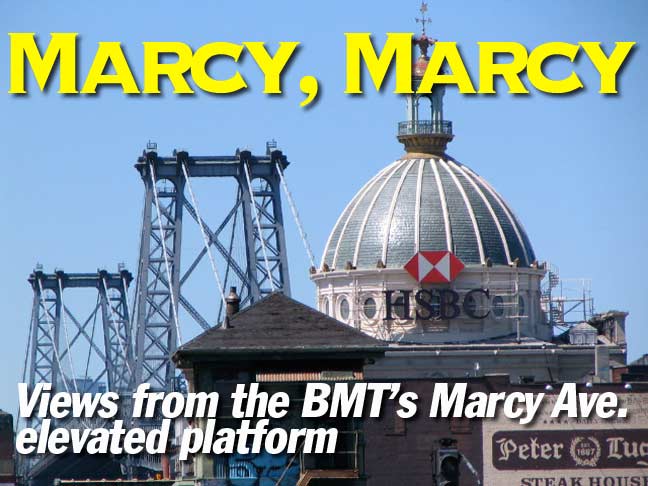
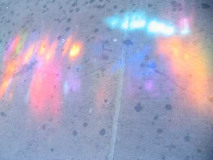
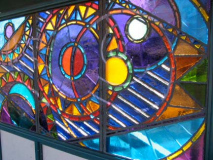
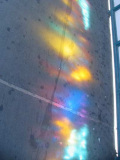
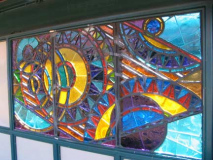


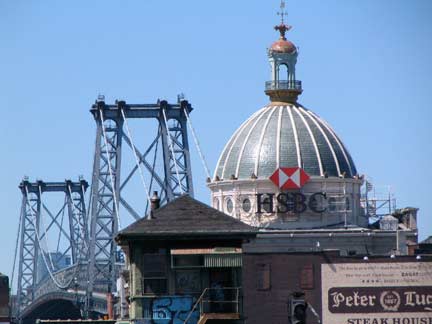




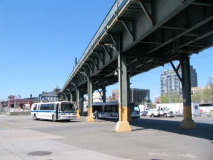
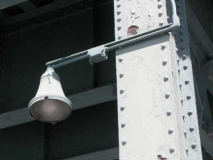
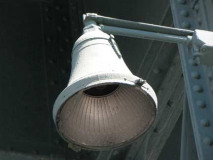
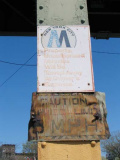

3 comments
Thie station is also unique because it the El is Chicago style, with the entrance houses on the platform level instead of a mezzaine between the street and platforms.
I grew up in Williamsburg. I wanted to let you know that the building that is now a Greek church was a courthouse when I grew up there in the 1950’s.
Certainly HSBC could have found a better way to affix its logo onto such a classic piece of architecture. For it to slap it on that dome in that fashion is criminal.